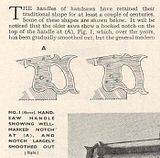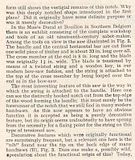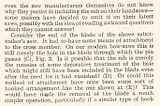Mirboo
Established Member
Attached below are some scans from the December 1959 edition of Woodworker magazine. The scans are from an article that puts forward a theory on the origin of handsaw nibs. It is an interesting theory and I thought some of you might like to read it.
The first scan below is a complete scan of the page from the magazine that featured the article in question.

Full article
If you find it a bit hard to read the text of the article with the page presented as a single scan (as above), I've sectioned it below so that it can be read more easily.

Part 1

Part 2

Part 3

Part 4

Figure 2 - The Sabot-Maker's Saw
The first scan below is a complete scan of the page from the magazine that featured the article in question.

Full article
If you find it a bit hard to read the text of the article with the page presented as a single scan (as above), I've sectioned it below so that it can be read more easily.

Part 1

Part 2

Part 3

Part 4

Figure 2 - The Sabot-Maker's Saw






